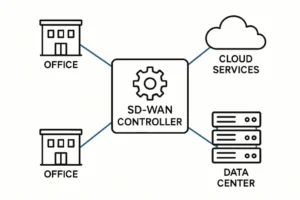Why Online Presence Matters for B2B Growth
In an era where digital interactions set the tone for nearly every business relationship, the online presence of a company is more than just a virtual business card—it’s a powerful driver for B2B growth. This invisible sales force relentlessly works in the background, capturing the attention of potential clients who begin their journey long before a formal sales discussion ever materializes. Research indicates that more than 70% of B2B buyers initiate their search for new vendors or partners online, underscoring the importance of early digital visibility. These initial, often anonymous, touchpoints are quietly shaping a prospective client’s opinion, experts suggest, long before they fill out a form or make a phone call.
After this research phase, high-value clients seek content that builds confidence and answers specific questions as they evaluate their options. Robust strategies like B2B SEO not only boost findability but also help a business deliver the right messages at crucial moments in a buyer’s journey. A sustained, multi-channel online presence positions your business as a serious contender for complex and high-value engagements, providing 24/7 access to your narratives and capabilities, well beyond the reach of traditional sales teams.
Crafting a Trustworthy Digital Foundation
First impressions are made at lightning speed in the digital world. Within just a few seconds of landing on a site or LinkedIn page, high-value prospects make judgments about your credibility and competence. Professional design and consistent branding across all online platforms are not just “nice-to-haves”; they are essential markers of trustworthiness in today’s B2B landscape. Missing or outdated details, inconsistent messaging, or slow-loading pages can cause clients to quietly exit, likely never to return. Including rigorous case studies, transparent privacy policies, and comprehensive leadership bios provides reassurance, reducing friction for buyers who are evaluating risk and reliability.
According to the Content Marketing Institute, the most effective B2B marketers focus on creating valuable, relevant content that is easy for prospects to find and navigate. They recommend regular site audits, clear calls to action, and responsive support options, ensuring that every interaction supports rather than detracts from the trust-building process. The companies that invest in a seamless digital experience often report an increase in both lead quality and shorter sales cycles.
Content Strategies That Cultivate Leads
Exceptional content serves as the magnet drawing high-value clients into genuine engagement. Beyond blog posts, modern B2B sites offer white papers, webinars, research reports, and video series—each carefully tailored to different stages of the buyer’s journey. Educational materials that address industry-specific challenges go a long way in showing expertise, reducing perceived risk, and building a track record of thought leadership. A well-structured content library can provide value even before a prospect contacts sales, helping clients to self-educate and reinforce their decision to connect.
- Create detailed case studies that showcase your ability to deliver measurable results for similar organizations.
- Offer downloadables and how-to guides focused on common industry pain points.
- Repurpose your content into multiple formats—such as podcasts or infographics—to expand reach and cater to varying learning styles.
Storytelling, when woven organically into your content, humanizes even the most technical B2B offerings. Relatable narratives and customer journeys enable buyers to envision themselves as the next success story, prompting a natural, deeper exploration of your solutions.
Search Strategies for High-Value Discovery
Appearing in key search results isn’t an accident. It requires a deliberate combination of keyword research, technical website optimization, and a content strategy that addresses buyer intent. B2B buyers often conduct dozens of searches before ever reaching out, so being consistently visible at every stage of their research is crucial for establishing trust and authority. By focusing on intent-driven keywords, resource hubs, and authoritative content, businesses ensure they’re showing up for even the most niche and lucrative opportunities.
Ongoing optimization—including structured data, internal linking, and backlink building—makes sure your “digital storefront” remains discoverable as algorithms and user expectations evolve. With the right approach, your online presence functions as an ever-alert sales agent, ready to engage prospects at their moment of need and nurturing them toward a decision with no manual effort required.
Using Data to Sharpen Your Digital Approach
Data-driven refinement is the secret weapon of a successful invisible sales force. Every visit, click, and interaction on your digital platforms tells a story about what resonates with your target audiences—and what does not. Savvy B2B marketers meticulously track performance via analytics dashboards, measuring time on site, conversion rates, form completions, and which sources yield the highest quality leads.
- Analyze which content assets deliver the most conversions and replicate those themes or formats.
- Test different headlines, layouts, and value propositions in ongoing A/B experiments.
- Double down on the most effective referral sources, whether organic search, industry media, or social platforms.
Monitoring this data allows for agile changes. Rather than a set-it-and-forget-it approach, continuous optimization keeps your digital approach relevant, resource-efficient, and aligned with shifting client preferences, making your invisible sales force smarter with each interaction.
Aligning Online Experience With Client Expectations
High-value buyers are looking for validation at every touchpoint. They expect digital experiences that feel as effortless and intuitive as the best consumer platforms. Performance issues, clunky navigation, or a lack of mobile optimization can break trust immediately, often before any human interaction occurs. That’s why best-in-class B2B organizations invest in UX design, mobile-first layouts, and above-the-fold clarity.
Enhancing engagement with tools such as live chat, interactive pricing calculators, and robust FAQ sections can further support prospective clients as they move from curiosity to consideration. Quick access to relevant case studies and leadership profiles also assures buyers that your team understands their sector and is accessible.
Measuring Success and Making Adjustments
Long-term success in B2B client attraction is more than gathering high lead volumes. It’s about generating the right leads—the organizations that will become lasting, profitable partners. Shape your key performance indicators around high-value conversions, pipeline velocity, and average deal sizes. Don’t discount metrics like webinar participation or social shares, either, since these signal increased brand trust and engagement even before a deal closes.
Consistent feedback loops, including post-engagement surveys and interview debriefs with newly won clients, reveal gaps and new opportunities. Revisiting analytics on a monthly basis and holding “lessons learned” sessions strengthens both strategic planning and digital agility. This process of minor, regular adjustments becomes your edge, helping to reduce acquisition costs and increase the effectiveness of every digital channel.
Future Trends in Attracting High-Value B2B Clients
The role of the invisible sales force is likely to become even more influential as buyer behavior evolves and digital tools become more sophisticated. Technologies such as artificial intelligence, predictive analytics, and real-time personalization will enable businesses to fine-tune their outreach and deliver tailored experiences at scale. This means the sales journey will feel more personal, while automation handles repetitive, behind-the-scenes tasks.
Staying ahead requires more than periodic website refreshes. Businesses must track emerging digital trends, invest in new platforms or content types, and welcome client feedback as a foundation for improvement. By doing so, they don’t just compete for today’s high-value clients—they stay visible and credible as those clients’ needs and the market itself evolve.
Also Read- 150+ Funeral Songs: A Healing Musical Journey








